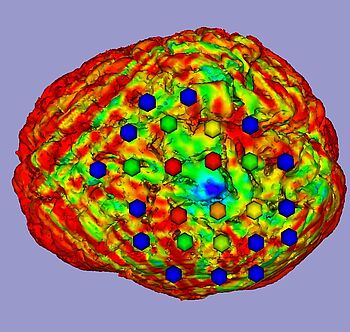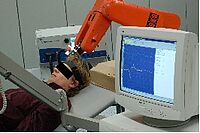Transkranielle Magnetstimulation
Projektbeschreibung
Ziel des Projektes ist die Entwicklung eines robotischen Assistenzsystems für TMS. Des Weiteren arbeiten wir an einem statistischen Kartifizierungsalgorithmus, der es ermöglicht, funktionelle Repräsentationen einzelner Muskeln im Gehirn darzustellen.
Die Vorteile der robotergestützen TMS sind vielfältig:
- Präzise Ansteuerung der Stimulationsziele.
- Präzise Orientierung der TMS-Spule tangential zum Kopf.
- Einfache Planung und schnelle Abarbeitung von gitterförmigen Stimulationsmustern.
- Bewegungskompensation hält die Spule am Zielpunkt bei Kopfbewegungen. Eine Fixierung des Patienten ist nicht mehr erforderlich.
- Wiederholbarkeit der Versuche.
Der Kartifizierungsalgorithmus verwendet alle drei maßgeblichen Informationen: Die Spulenpositionen für die Stimulation, die erhaltenen Muskelantworten und das charakteristische Feld der TMS-Spule. Die Grundidee des Algorithmus besteht in der Annahme eines monotonen funktionellen Zusammenhangs zwischen elektrischer Feldstärke am Repräsentationspunkt und der erzielten Muskelantwort. Mittels eines modifizierten Korrelationsverhältnisses und dem Kendallschen Rangkoeffizienten TAU berechnen wir eine Wharscheinlichkeitskarte für die Position der Muskelrepräsentation.

Veröffentlichungen
2015
Microstructure of the superior longitudinal fasciculus predicts stimulation-induced interference with on-line motor control, Neuroimage , vol. accepted for publication, 2015.
2013
Design, implementation and evaluation of an independent real-time safety layer for medical robotic systems using a force-torque-acceleration (FTA) sensor, International Journal of Computer Assisted Radiology and Surgery , vol. 8, no. 3, pp. 429-436, 2013.
| DOI: | 10.1007/s11548-012-0791-5 |
| Datei: | s11548-012-0791-5 |
Optimal Coil Orientation for Transcranial Magnetic Stimulation, PLoS ONE , vol. 8, no. 4, pp. e60358, 2013.
| DOI: | 10.1371/journal.pone.0060358 |
| Datei: | journal.pone.0060358 |
Robotized Transcranial Magnetic Stimulation., .... New York: Springer, 2013.
| ISBN: | 978-1-4614-7359-6 |
| Datei: | 978-1-4614-7359-6 |
Stimulus intensity for hand held and robotic transcranial magnetic stimulation, Brain Stimulation , vol. 6, no. 3, pp. 315-321, 2013.
| DOI: | 10.1016/j.brs.2012.06.002 |
| Datei: | j.brs.2012.06.002 |
Tracking post-error adaptation in the motor system by transcranial magnetic stimulation, Neuroscience , vol. 250, pp. 342-351, 2013.
| DOI: | 10.1016/j.neuroscience.2013.07.024 |
| Datei: | j.neuroscience.2013.07.024 |
2012
Calibration of Force/Torque and Acceleration for an Independent Safety Layer in Medical Robotic Systems, Cureus , vol. 4, no. 9, pp. e59, 2012.
| DOI: | 10.7759/cureus.59 |
| Datei: | cureus.59 |
Comparison of stimulus intensity in hand held and robotized motion compensatedtranscranial magnetic stimulation, Neurophysiologie Clinique/Clinical Neurophysiology , vol. 42, no. 1-2, pp. 61-62, 2012.
| DOI: | 10.1016/j.neucli.2011.11.028 |
| Datei: | j.neucli.2011.11.028 |
Hand-assisted positioning and contact pressure control for motion compensated robotized transcranial magnetic stimulation, Pisa, Italy: Springer Berlin / Heidelberg, 2012. pp. 123-124.
| DOI: | 10.1007/s11548-012-0708-3 |
| Datei: | s11548-012-0708-3 |
Non-orthogonal Tool/Flange and Robot/World Calibration for Realistic Tracking Scenarios, International Journal of Medical Robotics and Computer Assisted Surgery , vol. 8, no. 4, pp. 407-420, 2012.
| DOI: | 10.1002/rcs.1427 |
| Datei: | rcs.1427 |
Roboternavigierte Untersuchung der Tiefenabhängigkeit der Reizstärke bei der transkraniellen Magnetstimulation, Klin Neurophysiol , vol. 43, no. 1, pp. 49-49, 2012.
Safe and clinically applicable robotized Transcranial Magnetic Stimulation, 2012.
The Effect of Repetitive Transcranial Magnetic Stimulation on Monoamine Outflow in the Accumbens Nucleus Shell in Freely Moving Rats, Neuropharmacology , vol. 63, no. 5, pp. 898-904, 2012.
Variation of Stimulation Intensity in Transcranial Magnetic Stimulation with Depth, Journal of Neuroscience Methods , vol. 211, no. 2, pp. 185-190, 2012.
| DOI: | 10.1016/j.jneumeth.2012.09.007 |
| Datei: | j.jneumeth.2012.09.007 |
2011
IS POST ERROR SLOWING A POST ERROR INHIBITION? A TRANSCRANIAL MAGNETIC STIMULATION APPROACH, Palma, Mallorca, Spain , 2011.
| DOI: | 10.3389/conf.fnhum.2011.207.00385 |
| Datei: | conf.fnhum.2011.207.00385 |
Navigated and Robotized Transcranial Magnetic Stimulation based on 3D Laser Scans, Lübeck, Germany: Gesellschaft für Informatik (GI), 2011. pp. 164-168.
Realisierung einer schnellen und wiederholbaren Hot-Spot-Bestimmung für die robotergestützte Transkranielle Magnet-stimulation mittels Kraft-Momenten-Steuerung, CURAC, 2011. pp. 31-34.
Robust robot-camera calibration for robotized Transcranial Magnetic Stimulation, International Journal of Medical Robotics and Computer Assisted Surgery , vol. 7, no. 4, pp. 414-422, 2011.
| DOI: | 10.1002/rcs.411 |
| Datei: | rcs.411 |
Threshold for Transcranial Magnetic Stimulation of the foot: precise control of coil orientation with a robotized system, Klin Neurophysiol , vol. 42, no. 01, pp. P280, 2011.
| DOI: | 10.1055/s-0031-1272727 |
| Datei: | s-0031-1272727 |
Fast robotic compensation of spontaneous head motion during Transcranial Magnetic Stimulation (TMS), Coventry, United Kingdom; Coventry, UK , 2010. pp. 872-877.
| ISBN: | 978-184600-0386 |
Kraft-Momenten-Steuerung für die robotergestützte Transkranielle Magnetstimulation (TMS), 2010.
Robot-assisted image-guided transcranial magnetic stimulation for somatotopic mapping of the motor cortex: a clinical pilot study, Acta Neurochirurgica , vol. 152, no. 2, pp. 333-343, 2010.
| DOI: | 10.1007/s00701-009-0565-1 |
| Datei: | s00701-009-0565-1 |
Simulation of a Conductive Shield Plate for the Focalization of Transcranial Magnetic Stimulation in the Rat, Armentano, Ricardo and Hudson, Donna and Monzon, Jorge and Patton, Jim, Eds. Buenos Aires, Argentina , 2010. pp. 1593-1596.
| ISBN: | 978-1-4244-4124-2 |

- Forschung
- SonoBox: Ein Roboter-Ultraschallsystem zur Diagnose von Unterarmfrakturen bei Kindern
- Robotics Laboratory (RobLab)
- OLRIM
- MIRANA
- Robotik auf der digitalen Weide
- KRIBL
- Ultraschallgeführte Strahlenchirurgie
- Digitaler Superzwilling: Projekt TWIN-WIN
- - Abgeschlossene Projekte -
- Hochpräzise Bewegungsverfolgung am Kopf in der Strahlentherapie
- Neurologische Modellierungen
- Modellierung von Herzbewegungen
- Bewegungskompensation in der Strahlentherapie
- Navigation and Visualisation in Endovascular Aortic Repair (Nav EVAR)
- Autonome Elektrofahrzeuge als urbane Lieferanten
- Ziel-basierendes lebenslanges autonomes Lernen
- Transkranielle Elektrostimulation
- Bestrahlungsplanung
- Transkranielle Magnetstimulation
- Navigation in der Leberchirurgie
- Stereotaktische Mikronavigation
- OP - Mikroskop
- Interaktiver C-Arm
- OCT-basierte Neurobildgebung
Achim Schweikard

Gebäude 64
,
Raum 94
achim.schweikard(at)uni-luebeck.de
+49 451 31015232
Floris Ernst

Gebäude 64
,
Raum 97
floris.ernst(at)uni-luebeck.de
+49 451 31015200
Ehemalige Projektmitarbeiter
- Dr. Ing. Fernando Gasca
- Dr.-Ing. Lars Richter
- Dr.-Ing. Lars Matthäus

